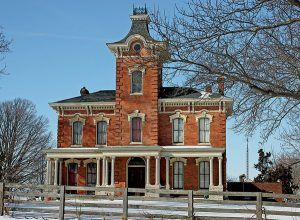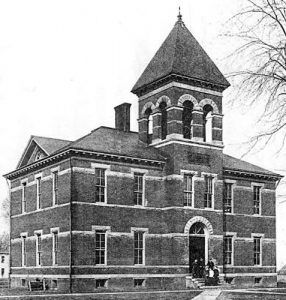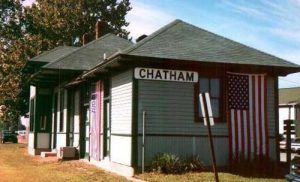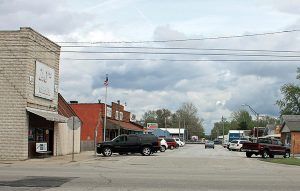About nine miles south of Springfield is Chatham, home to about 10,000 residents and one of the fastest-growing areas in central Illinois. The town started when the first settlers arrived in 1816 to take advantage of the fertile prairie land between Lick and Panther Creeks in Sangamon County. Farming families soon had plentiful fields of corn in the area, attracting more settlers, even though there was a risk of Indian attacks.
One of the earliest settlers was John Campbell from Tennessee, who settled on Lick Creek and built an old-fashioned horse mill. Other early pioneers included Henry Brown, John Darneille, brothers Levi and Samuel Harbour, and Baptist Minister Simon Lindley. In 1821, the Baptists organized the first church; the following year, the area had grown enough for a school held in a small log cabin, which Ira McGlassen taught. The first water mill was a sawmill, built and run by Johnson Hardin, on Lick Creek, in about 1828.
The village of Chatham was officially laid out in October 1836 by Luther N. Ransom, who built the first house of logs. However, the town would grow slowly during the first two decades. The school was first held in the newly founded village in 1837 in Luther N. Ransom’s smokehouse. Roxana S. Lyman taught it.
Many of its residents were closely intertwined with Abraham Lincoln during Chatham’s early years. In 1837, two state senators and seven representatives from Sangamon County managed to convince the General Assembly to move the State Capitol from Vandalia to Springfield. These legislators, called the “Long Nine,” included Lincoln and John Dawson. Lincoln was a good friend of Reverend Josiah Porter, minister of the Chatham Presbyterian Church. Dr. John Lewis of Chatham and Abraham Lincoln surveyed and purchased rights to build the railroad from Springfield through Chatham to St. Louis, Missouri.
In 1838, a post office was established, and the mail was brought by a stage running from Springfield, Illinois, to St. Louis, Missouri. A frame schoolhouse was built in 1839, serving the village for the next 19 years. Later, when the number of students outgrew the building, it was used as a grocery store.
When the Chicago, Alton, & St. Louis Railroad came to town in 1852, the village began to grow. The first steam grist mill was erected four years later by S.N. Fullenwider, which would manufacture flour for the next several years. In 1858, a new two-story school was built.
One of Chatham’s most famous residents was Ben F. Caldwell, who moved near the town with his parents when he was just a boy. His formal school education ended at age 15 when his father died. Caldwell became active in real estate, banking, and livestock raising and eventually owned 1000 acres of farmland in the area. In 1876, he built the towered Italianate-style mansion on Route 4 north of Chatham. He also was a partner and served as President of the Bank of Chatham, which opened for business in January 1880. He also served as president of the Farmer’s State Bank in Springfield and the Illinois House and Senate before becoming a U.S. Representative in 1899. The 6,000-square-foot residence and immaculate barn sit on five acres and are listed on the National Register of Historic Places. It is privately owned.
By the early 1880s, the town sported three church buildings, including the Presbyterian, Methodist, and Baptist, and seven schools in the Chatham Township.
In 1895, Ben Caldwell also paid for a new school for the city of Chatham, named Caldwell School. The school was used as a combination grade and high school until 1904, when it was destroyed by fire. A new school was built in 1905 and also called Caldwell School. It continued to be utilized as a combination school until 1938, when it served as a grade school only until 1961. Three years later, it also was destroyed by a fire in 1964.
Over the years, Chatham moved into the 20th Century and welcomed the travelers of Route 66 with the typical service stations and restaurants. As it continued to grow over the years, its businesses moved to the north, closer to Springfield, which is now a typical suburban-like sprawl of strip malls and fast-food restaurants.
However, Chatham still offers a few glimpses into its past — one at the Chatham Railroad Museum housed in the 1902 depot building. In the early 1900s, 12 passenger trains came through Chatham daily. After 70 years of service, the station was closed with the merger of Illinois Central and the Gulf, Mobile & Ohio Railroads in 1972. In 1991 it was restored and turned into a museum located at 100 N. State Street. Chatham’s earlier Mulberry Street business district also has a few old buildings.
Today, this village offers the conveniences of the larger nearby city of Springfield while still providing small-town charm. The city hosts the Chatham Sweet Corn Festival, and Illinois Championship Cow Chip Throw each July.
Continue southward on IL-4 as your Route 66 journey moves on to Auburn. About four miles south of Chatham, before you reach the town of Auburn, watch to the west for Snell Road. At 5029 Snell Road is Becky’s Barn, a Route 66 snack shop, information center, and antique store. It is located right off the historic 1931 1.4-mile hand-laid brick road.
More Information:
Chatham, Illinois
116 E Mulberry
Chatham, Illinois 62629
217-483-2451
© Kathy Alexander/Legends of America, updated January 2023.
Also See:







